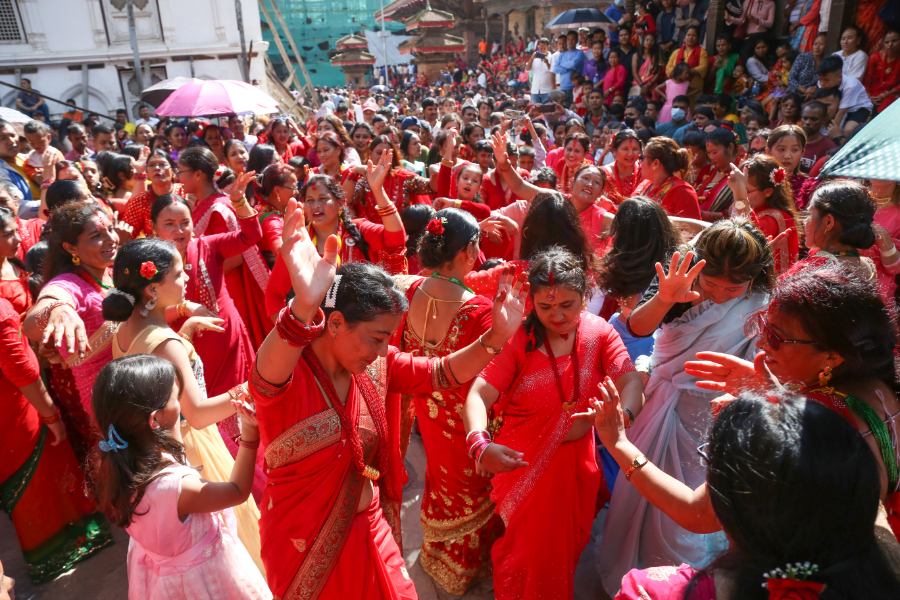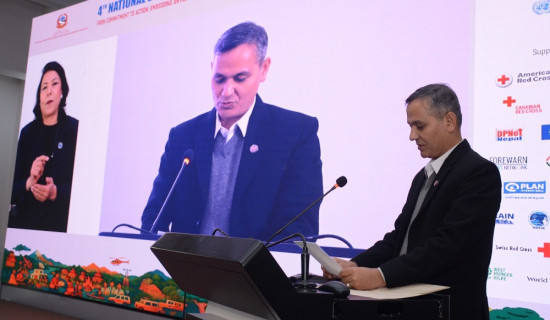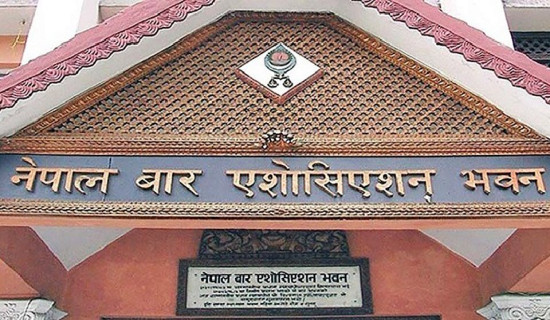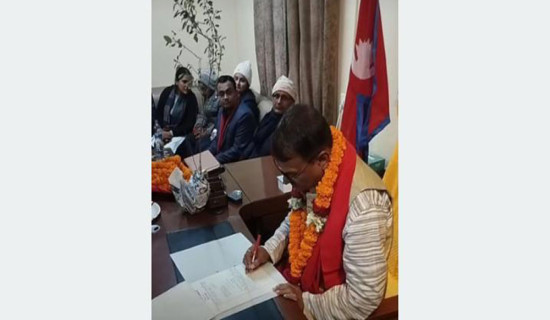- Monday, 22 December 2025
Unravelling Teej: Tracing gender dynamics and patriarchy in the festival
Palmo Dawa Tamang
 Teej, the traditional Hindu festival celebrated with great
enthusiasm, is once again upon us. The sights and sounds of the vibrant
festival has filled the bustling markets, digital social platforms, and lively
conversations. However, beneath the surface of this seemingly joyous
celebration, there exists a complex tapestry of gender dynamics, woven over
centuries, that calls for our scrutiny. This article endeavors to delve into
the multifaceted dimensions of Teej and assess its role in either perpetuating
or challenging the patriarchal system, driven by the discussions held among my
colleagues, classmates, neighbors, and women who has been following the ritual.
Teej, the traditional Hindu festival celebrated with great
enthusiasm, is once again upon us. The sights and sounds of the vibrant
festival has filled the bustling markets, digital social platforms, and lively
conversations. However, beneath the surface of this seemingly joyous
celebration, there exists a complex tapestry of gender dynamics, woven over
centuries, that calls for our scrutiny. This article endeavors to delve into
the multifaceted dimensions of Teej and assess its role in either perpetuating
or challenging the patriarchal system, driven by the discussions held among my
colleagues, classmates, neighbors, and women who has been following the ritual.
Teej: product of patriarchal system
"We all participate in
something larger than ourselves, something we didn’t create but that we have
the power to affect through the choices we make about how to participate."
(Johnson: Patriarchy, The System). This statement holds especially true when
examining Teej through a gender lens. Teej, deeply rooted in tradition, is a
product of this patriarchal system. It is upon us to recognize our role in this
system. The system is running us all (Keen: patriarchy, the
system) as said in the statement we act to fit in the system, the
patriarchal system, which have significant influence on individuals and society
as a whole that it is deeply ingrained in our collective consciousness and
culture, deeply ingrained in shaping our behaviors, attitudes, interactions and
thought process. It emphasizes the need for critical analysis and efforts to
challenge and dismantle these systems to achieve gender equality and social
justice.
Teej finds its roots in Hindu mythology, celebrating the day
Lord Shiva accepted Godess Parvati being impressed by Parvati's
unwavering love and dedication for him. Parvati's Nirjala Vrata, a fast without
food or water, symbolized her commitment. Imitating her devotion, Hindu women
in Nepal observe this fast, praying for their husbands' longevity and family's
well-being, while unmarried women hope for their dream husbands. I have always
pondered why women has to fasts for their husband and how their fasting is
connected with the health and longevity of their husband’s life.
Yes,
Teej has evolved, but the main change is in the way of fasting. These days
women drink juices if their bodies ask for it, but the main story behind
celebrating Teej is the same - the story of Parvati’s dedication to Shiva. The
center of attraction for the day is “HUSBAND/MAN.” The central theme of Teej
revolves around the devotion of wives to their husbands, often portraying women
as submissive and self-sacrificing. This reinforces traditional gender roles,
placing women in a subservient position while prioritizing the husband's
well-being and happiness.
It’s
time to understand that it is a product of the patriarchal system: patriarchy
subordinates and oppresses women at various levels and intensities (Walby,
1990). It has deeply penetrated in the society and individual that we enjoy the
festival and rituals as the process of a natural phenomenon. During Teej,
married women fast from dawn to dusk without consuming food or water, with the
belief that their strict fasting will ensure the longevity and prosperity of
their husbands. This practice promotes the idea that a woman's purity and
commitment to her husband is inevitable and that she can even endure physical
hardship for him.
Let's examine the various interpretations and claims
regarding Teej:
Some say Fasting is good for Health: Yes, Fasting indeed
has well-documented health benefits, and there is no debate on its
significance. However, Simone de Beauvoir's assertion that "one is not
born, but rather becomes a woman" highlights how traditional practices may
inadvertently reinforce hierarchies with men in the position of power, casting
women as second-class citizens. Patriarchy, as a system, has subordinated and
oppressed women at various levels and intensities (Walby, 1990). The fasting
rituals of Teej might unintentionally perpetuate this hierarchy, raising
questions about the messages we convey to our daughters regarding their
societal roles.
Fosters sisterhood and solidarity: Some argue that one of
most significant aspects of the festival is the gatherings as "Dar"
Parties”, organized by women themselves or related institutions. These
gatherings provide a platform for women to share their lived experiences with one
another. In this sense, Teej nurtures a sense of sisterhood and solidarity
among women, which can serve as a powerful catalyst for challenging patriarchal
values and dismantling gendered roles. However, have we leveraged this
sisterhood to bring about meaningful change in women's status, challenging
prevailing patriarchal values and norms?
Speech Freedom
Teej grants women the freedom to express themselves for a
day, allowing them to sing away their disappointments and sufferings. Yet, this
raises a critical question: Are we seeking approval from men even for the
freedom of speech? Who assigned us the day to freedom of speech? The historical
marginalization of women and their dignity being contingent upon male approval
makes us question the essence of true liberation. Teej celebrations should be
scrutinized to determine whether they inadvertently reinforce patriarchy or
genuinely empower women.
Mental Well-Being
Another perspective posits that Teej offers a space for
women, often victims of a patriarchal structure, to express their anger,
anxiety, and suffocation accumulated over the year. However, it leads us to
ponder: Is it healthy to condense a year's worth of frustration into a single
day? Perhaps, instead of reserving our voices for one day, we should strive for
open conversations about these issues every day to promote continuous mental
well-being.
It is essential to engage in open
discussions about whether Teej is a product of the patriarchal system.
Traditional Teej may inadvertently reinforce this system rather than challenge
it for women's equality. Teej exists within social relational contexts that
significantly shape and perpetuate gender systems Ridgeway according to Correl,
unpoacking Gender System. To effectively challenge patriarchy, we must
critically assess these beliefs and their impact within social contexts,
recognizing our roles in shaping or perpetuating this system.
Teej is often accompanied by campaigns raising awareness
about oppression and advocating for women's rights. While these initiatives are
commendable, campaigners and activists seldom critically analyze the festival
itself. It is crucial to consider how the celebration of Teej might
inadvertently strengthen women's subordination, prompting us to rewrite the
scripts of Teej to address contemporary issues more effectively.
Teej reflects the complexities of gender dynamics within our
society. It serves as a mirror, showcasing both the strengths and weaknesses of
our collective efforts toward gender equality. As we approach Teej once again,
let us use this opportunity to engage in constructive conversations, challenge
stereotypes, and work towards a future where women can celebrate their
liberation without seeking anyone's approval.
In
conclusion, Despite attempts to
modernize Teej, the core message of women's devotion to their husbands remains
largely intact. This perpetuates the idea that a woman's primary role in
society is to be a dutiful wife, prioritizing her husband's well-being above
her own desires and needs.
It is a festival that embodies complex gender dynamics. It serves as a reminder
that our traditions and celebrations can both reflect and influence societal
norms. Teej, as a product of the patriarchal system, requires a closer
examination. It's up to us as individuals to shape, re-shape its meaning and
impact on our lives. Let’s re-write or write a new script that fits the
contemporary society that emancipates women and creates the society with
equality and justice.
(The author is a social activist with specialisation in GESI and she can be reached at palmotp@gmail.com)












-original-thumb.jpg)



